
The Technique Solar Module is the most advanced solar power production unit in the world today; there is simply nothing that compares with it. HWH is the exclusive supplier of the Technique Solar Module to the mining industry.
|
Technique Solar Module (TSM)
|
Traditional Photovoltaic (PV) Solar System
|
|
Tracks the Sun to maximize solar capture and energy production during sunlight hours
|
Static panels fluctuate in performance based upon the sun's position at various times of the day
|
|
System efficiency produces nominally 60% conversion rate of energy from 100% of Sun
|
System efficiency of maximum 18% energy from 100% of Sun on panels at 25°C
|
|
Minimal reduction in electrical/heat energy generated during working life of the TSM due to more uniform temperatures
|
Continual degeneration of efficiency each and every year of life of PV system due to extreme temperature fluctuations
|
|
Active collection area is 3.5 M2 to produce 2.1kW
|
Panel area is in excess of 25 M2 to produce 2.1kW
|
|
Small design feature that can be located almost anywhere and in any quantities required
|
Significantly large surface areas required for panels that reduce options for installations
|
|
Performance efficiencies are not adversely affected by dirt, bird droppings, shading, extreme heat etc.
|
Performance of each panel is significantly affected by dirt, bird droppings and/or shading etc.
|
|
Figures based upon real-life conditions in specified geographic areas
|
Figures based upon STC (standard test conditions) which include a temperature of 25°C, 1000 w/M2, 1.5 AM (air mass)
|
This module:
Tracks the sun across it’s axis to maximise solar return
Is designed to concentrate the rays of the sun maximising energy production.
Is a unique combination producing both solar power and solar hot water.
Tracks the sun across it’s axis to maximise solar return
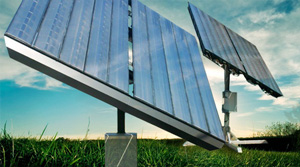
Is designed to concentrate the rays of the sun maximising energy production.
Is a unique combination producing both solar power and solar hot water.






Is comprised of a series or string of PV cells which form a solar panel which is traditionally glass covered, with a glass composite backing material that creates an encapsulated 'hothouse' effect. Standard PV specifications are obtained under the Standard Test Conditions (STCs): 1000 W/m2 solar irradiance, 1.5 Air Mass and cell temperature of 25°C.
If the ambient atmospheric temperature is 25°C, then the panel temperature will be approximately 60°C as a result of the PV cells being heated to 35% above the ambient temperature. This increase in cell temperature is due to the 'hothouse' effect and has a detrimental effect on the energy output performance of the cell which in turn, impacts on the performance of the traditional solar system in the following manner:
For every 1°C increase in the temperature of a PV cell, there is up to a 0.6% decrease in the efficiency of that cell. Accordingly, if the ambient temperature is 25°C, the traditional solar panel will reach a temperature of 60°C (25°C + 35°C) which means that the traditional PV system will lose efficiency output of up to 21% of its stated efficiency. This means that if a PV cell is rated under Standard Test Conditions at achieving an efficiency of 15%, then on a 25% C day, the cell's efficiency is reduced to 11.85%.
If there is not direct solar radiation on the cell due to dirt build-up, bird droppings or shading from tress or buildings, then the entire solar panel may be rendered totally inefficient. The affected area only needs to be the size of a 50 cent coin and therefore the risk of a reduction in the system efficiency is high.



Through tracking the sun, the TSM captures more sunlight. This sunlight is then directed onto the TSM's heat exchangers after passing through a uniquely designed lens at an efficiency conversion rate of 70 – 80%. As a result of this high conversion rate, the TSM as a solar energy generating system generates in excess of 60% efficiency.
By recirculating water through the TSM heat exchanging array, a uniform temperature is maintained throughout the cells. This uniform temperature allows the TSM to maintain an efficiency of energy production.
The TSM captures 40% more direct sunlight, when compared to traditional PV solar systems, due to its unique tracking system. Therefore, if a TSM is located in a location where there is an average of 8 sun hours per day, the TSM will receive in excess of 11 sun hours per day, which on annualised basis, will produce in excess of 8,000 kwhrs of combined heat and electrical energy.
The TSM produces electrical and heat energy, stored as hot water. This hot water accounts for 70% of the energy being produced with the remaining 30%, electrical energy production.
Additional energy is collected and stored and can be utilised after the sun goes down whereas the PV system is rendered useless after the sun goes down.
Heat energy driven air-conditioners can utilise the heat energy produced by the TSM.






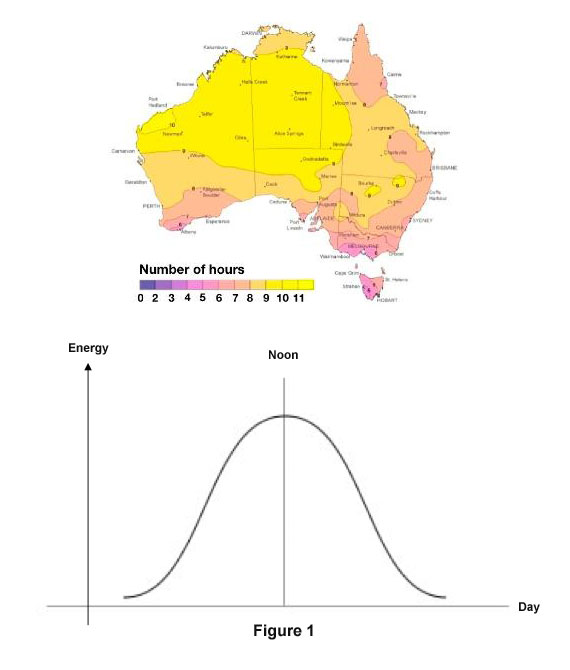
Figure 1 represents a typical one day period, with the produced energy increasing until noon, then reducing in the afternoon before diminishing in the evening. This is representative of a traditional flat panel PV system performance.
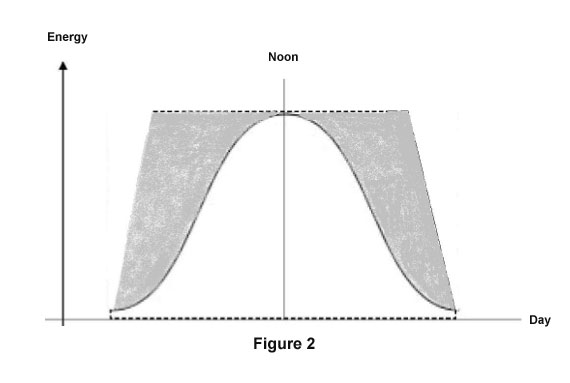
Figure 2 above overlays the TSM difference indicating that the TSM (shaded grey area) generates energy quicker and produces energy longer on a typical day. Due to its greater efficiency and system performance outputs, the TSM typically has a 40% performance increase over a flat panel PV system.

Figure 3 shows the heat cycle of a PV system in peaks and troughs. The TSM system temperature over time is represented by the thick dashed line indicating uniform temperature held. This significant variance is a result of the unique design of the TSM system.
Note that the TSM system operates at a uniform frequency and that this uniformity prolongs the life of the TSM system whereas a PV system with its significant temperature fluctuation decreases the life of the PV system.
How the TSM Works
Incoming solar radiation is concentrated as it passes through the unique TSM lenses onto the angled walls of a 10-trough assembly that then reflect the sunlight down onto PV cells and heat exchangers strategically positioned at the bottom of the trough system. The resultant generating efficiencies are multiplied many times when compared to traditional PV systems. Specifically a TSM will generate 2.1 kilowatts from a collection area of 3.5 M2 module whereas a conventional PV system will require more than 7 times this area to generate the same output.
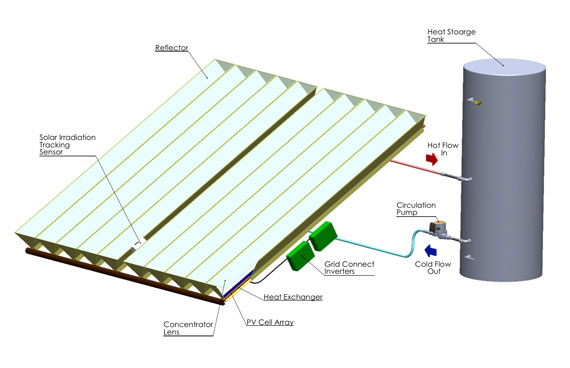
The Technique Solar technology breakthrough makes it possible to now deliver solar energy economically and more efficiently than other currently known forms of solar energy production.
The features are as follows:
It will deliver an energy output at a substantially lower cost than the existing cost of energy from conventional PV panels.
It enables solar energy to be provided to the consumer using modules that will supply both heat energy (hot water) and electrical energy.
The modules can be supplied and installed at a cost which does not require the need for Government subsidies or rebates.
In addition the owner of the module may gain a financial benefit which would apply from the expected Small-scale Technology Certificates (STCs) and/or Renewable Energy Certificates (RECs) as well as any future Carbon Credits.





Unit 1, 32 Peel Street, Eltham VIC 3095
Phone: 03 9431 3333 | Fax: 03 9431 1888 | Email: info@hwhholdings.com.au
Hours: 7am–4.30pm Monday to Friday

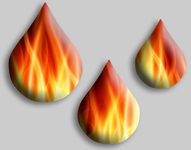

Customised Environmental Solutions for the Building, Solar and Hot Water Industries









